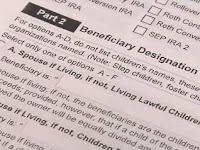In the current issue of its newsletter, Employee Plans News (Issue 2013-3, September 13, 2013), IRS has an article on one of the differences between divorce and legal separation as it impacts employer retirement plan rules.
Background
In most employer retirement plans, a spouse is entitled to inherit plan benefits, even if another individual is named on the beneficiary form. A spouse must sign a waiver, usually provided by the plan, before an individual other than the spouse can inherit those benefits.
 Most plan participants complete a beneficiary form naming their spouse as the beneficiary of plan benefits. This can create problems later if the plan participant divorces that spouse and does not complete a new beneficiary form naming someone other than the ex-spouse as the new beneficiary of those plan benefits - if the participant has not remarried. At the plan participant’s death, the ex-spouse will inherit the plan benefits, even if they were waived as part of the divorce settlement.
Most plan participants complete a beneficiary form naming their spouse as the beneficiary of plan benefits. This can create problems later if the plan participant divorces that spouse and does not complete a new beneficiary form naming someone other than the ex-spouse as the new beneficiary of those plan benefits - if the participant has not remarried. At the plan participant’s death, the ex-spouse will inherit the plan benefits, even if they were waived as part of the divorce settlement.
To mitigate this problem, some plans incorporate a provision that automatically removes an ex-spouse as a plan beneficiary when the plan participant divorces. Some plans take this a step further and will also remove an ex-spouse when there is a legal separation.
In the article, IRS points out that the automatic removal of a spouse without spousal consent could cause a plan violation of the spousal death benefit rules. These rules state that a current spouse has certain entitlements to a death benefit in a qualified employer plan.
When a plan participant obtains a legal separation, they can change a beneficiary designation to a non-spouse beneficiary without obtaining a spousal waiver. However, the article states : “Although a legally separated participant can waive the spousal death benefit without spousal consent, a plan’s automatic revocation language, by itself, doesn’t satisfy the waiver rules.” This means that the separated spouse will remain the beneficiary of plan death benefits.
Plan participants should not rely on the plan language to determine the beneficiary of plan benefits. Beneficiary forms need to be updated whenever there is a significant life event such as a birth, death, adoption, divorce, or legal separation. The plan administrator is not going to monitor what is going on in a plan participant’s life and remind them to update their beneficiary forms. Make sure the money you worked so hard for is going to the beneficiaries that you choose.
- By Beverly DeVeny and Jared Trexler
Background
In most employer retirement plans, a spouse is entitled to inherit plan benefits, even if another individual is named on the beneficiary form. A spouse must sign a waiver, usually provided by the plan, before an individual other than the spouse can inherit those benefits.
 Most plan participants complete a beneficiary form naming their spouse as the beneficiary of plan benefits. This can create problems later if the plan participant divorces that spouse and does not complete a new beneficiary form naming someone other than the ex-spouse as the new beneficiary of those plan benefits - if the participant has not remarried. At the plan participant’s death, the ex-spouse will inherit the plan benefits, even if they were waived as part of the divorce settlement.
Most plan participants complete a beneficiary form naming their spouse as the beneficiary of plan benefits. This can create problems later if the plan participant divorces that spouse and does not complete a new beneficiary form naming someone other than the ex-spouse as the new beneficiary of those plan benefits - if the participant has not remarried. At the plan participant’s death, the ex-spouse will inherit the plan benefits, even if they were waived as part of the divorce settlement. To mitigate this problem, some plans incorporate a provision that automatically removes an ex-spouse as a plan beneficiary when the plan participant divorces. Some plans take this a step further and will also remove an ex-spouse when there is a legal separation.
In the article, IRS points out that the automatic removal of a spouse without spousal consent could cause a plan violation of the spousal death benefit rules. These rules state that a current spouse has certain entitlements to a death benefit in a qualified employer plan.
When a plan participant obtains a legal separation, they can change a beneficiary designation to a non-spouse beneficiary without obtaining a spousal waiver. However, the article states : “Although a legally separated participant can waive the spousal death benefit without spousal consent, a plan’s automatic revocation language, by itself, doesn’t satisfy the waiver rules.” This means that the separated spouse will remain the beneficiary of plan death benefits.
Plan participants should not rely on the plan language to determine the beneficiary of plan benefits. Beneficiary forms need to be updated whenever there is a significant life event such as a birth, death, adoption, divorce, or legal separation. The plan administrator is not going to monitor what is going on in a plan participant’s life and remind them to update their beneficiary forms. Make sure the money you worked so hard for is going to the beneficiaries that you choose.
- By Beverly DeVeny and Jared Trexler


















